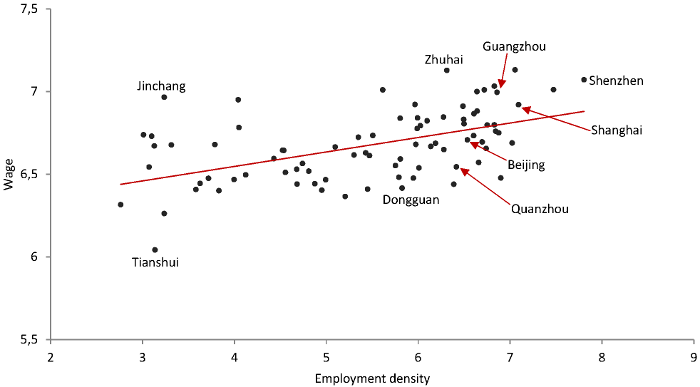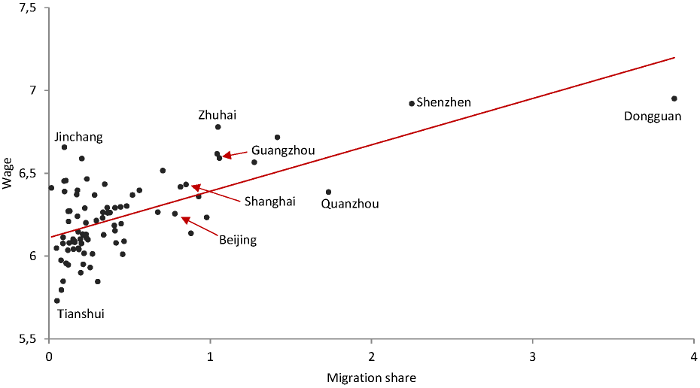The latest population census conducted in China in November 2010 portrayed a rapidly urbanising country, with the urban population reaching 49.7%, up 13.5 percentage points compared to 2000.
- After decades of highly regulated urbanisation – which led to significantly undersized cities (Au and Henderson 2006) – the unprecedented pace and scale of urbanisation fed by massive rural-labour exodus brings in new challenges and opportunities.
- With one billion people expected to live in Chinese cities by 2030, the country now faces extremely challenging policy choices in the management of the expanding urban population, the provision of adequate urban infrastructure and public services, and the securing of public safety and social stability.
Accelerating urbanisation can also be seen as an opportunity to sustain economic growth by capturing the benefits from urban agglomeration.
Too many cities with too few people?
Economic geography typically predicts positive returns to urban scale, which are related to a series of agglomeration effects including pure knowledge spillovers, the sharing of inputs, and the pooling of the labour force. Hence, urban scale may raise productivity, and therefore nominal wages, through a variety of channels including better technology, higher labour efficiency, higher prices of goods, and lower costs of other factors.
In the particular case of China, urbanisation is largely driven by the dramatic acceleration of rural-labour mobility since the early 2000s, which concomitantly raises concerns about the potential impact of migrant inflows on local resident’s labour-market outcomes. As rural migrants are significantly less educated than their urban counterparts, a major concern is that by increasing the relative supply of unskilled workers in cities, the inflow of rural migrants would exert a downward pressure on wages, particularly for unskilled local urban residents. This mirrors similar concerns for developed countries and international migrants. Nevertheless, there may well be complementarities between native and migrant workers (Meng and Zhang 2010) and in that case, the induced positive externality from migrants to local workers may offset the negative effect brought by the increase in unskilled labour supply.
In a recent work (Combes, Démurger and Li, 2013), we evaluate the magnitude of agglomeration economies in China and we explicitly account for the role of internal migration when estimating agglomeration economies. The empirical analysis relies on individual data gathered for 14,590 wage workers in 83 cities over 16 Chinese provinces for the year 2007. The database is restricted to urban Hukou holders only (those with a residency permit), and does not account for rural migrants. Hence, the observed wage disparities refer to urban residents (‘natives’) only and one should not infer that the wage determinants across Chinese cities we identify would equally apply to migrant workers.
There are huge wage gaps across cities, with the ratio of the highest average to the lowest being above five. A large geographical dispersion can also be observed in terms of both city size (employment density as well as land area) and wages. In 2007, the average employment density is 414 workers per square km but the ratio of the ninth to the first decile at 36.9 highlights large dispersion across cities. The geographical dispersion is clearly dominated by a coastal-inland gap, though there are also pockets of both densely populated and highly remunerating areas in inland provinces. Finally, descriptive statistics indicate a strong correlation between average city-level earnings and employment density, and compared to developed countries such as France (Combes, Duranton and Gobillon 2008), the estimated unidimensional elasticity at about 0.14 is clearly larger.
Larger gains from concentrating economic activities over space in China than in developed countries
We find that location matters for productivity in China. It explains a large share of nominal-wage disparities and even after controlling for individual and firms’ characteristics (and instrumenting city characteristics), the estimated elasticity of wage with respect to employment density is about three times larger than what is usually found for Europe or North America with similar specifications. Being located in a twice as dense city in China increases wages by 8.7%. We also find that agglomeration economies are more localised in China than there are in Western countries: the own-city density matters more, as do own-area and city specialisation, whereas the size of neighbouring cities matters less.
These estimates support Henderson’s statement on “too many cities with too few people” (2009) in China based on evidence for the mid-1990s and they indicate that there is still room for urban areas to further expand. The accelerating urbanisation pace that is being observed since the early 2000s in China is contributing to filling the gap. However, a related and highly debated issue in China remains opened on the optimal size of the future cities: should the expansion of already existing mega-cities or the development of medium-sized cities be favoured? What our findings suggest is that in 2007, there was potentially high efficiency losses due to a too strong dispersion of the population and that in comparison with 2002, agglomeration economies had not been fading out significantly despite a growing flow of rural-to-urban migration.
Figure 1 summarises the positive relationship between annual nominal wages net of individual and firms’ characteristics and employment density for the 83 cities under study. A few cities are indicated that highlight the clear inland-coastal gap: on the right-hand side, most very dense cities are located in Guangdong province, one of the most dynamic local economies in China; on the left-hand side, less dense cities are located in inland provinces (such as Tianshui in Gansu province or other cities in Yunnan and Shanxi provinces).
Figure 1. Chinese cities, 2007
Note: Jinchang and Tianshui are cities located in Gansu province; Quanzhou in Fujian province; Zhuhai, Guangzhou, Dongguan and Shenzhen in Guangdong Province. Variables are in log.
In addition to agglomeration effects, internal migration further increases productivity
Turning to internal migration externality, we find evidence of a positive and significant impact of the local share of migrants on local workers’ wages, which does not substitute much to other agglomeration gains. For instance, keeping the number of local workers constant, if migrants move to a city so that their share in total employment jumps from the first quartile of the distribution across Chinese cities to the last quartile, productivity in the city increases by 10%. Two thirds of the increase results from the externality exerted by migrants and one third results from agglomeration effects induced by the increase in total employment generated by this migration inflow. Hence, internal migration not only increases productivity through the increase of employment density it leads to, but also because migrants exert a positive externality on local workers' wages.
These findings add to accumulating evidence of rural migrants' contribution to the country's economic growth and industrialisation. They support the hypothesis of a complementarity, rather than a crowding out, that migrants bring in to local workers. This is fully consistent with rural migrants being mainly concentrated in low-end labour-intensive industries that feed other local industries, thus contributing to an overall improvement of urban productivity.
Figure 2 illustrates the relationship between the migrant share and annual wages (net of individual and firms’ characteristics). Again, cities located in Guangdong province that are already benefiting from high density (as Shenzhen for instance) also exhibit both higher migration share and wages. In contrast, inland cities such as Tianshui suffer from both low density and absence of migrants. Finally, one also observes that some cities benefit more from density but less from migration (e.g. Shanghai), and vice versa (e.g. Dongguan).
Figure 2. Chinese cities, 2007
Note: Jinchang and Tianshui are cities located in Gansu province; Quanzhou in Fujian province; Zhuhai, Guangzhou, Dongguan and Shenzhen in Guangdong Province. Variables are in log.
Beyond the overall large estimated impacts of employment density and migration on urban productivity, there may be heterogeneous effects of agglomeration across individuals depending on skills, occupations, gender, etc. Heterogeneity in the effect of place-based externalities on individual earnings is not covered in the paper but in terms of optimal local economic structure, there is potential for future research along such lines. Furthermore, whether spatial concentration increases individual welfare is not under study here either. To evaluate that, one should also estimate how the cost of living increases with city size and compare the productivity gains we exhibit to these costs. The literature on that topic is only burgeoning, even for Western countries, but it is clearly another interesting direction to explore for China.
References
Au, Chun-Chung and J Vernon Henderson (2006), “Are Chinese cities too small?”, The Review of Economic Studies 73, 549-576.
Combes, Pierre-Philippe, Sylvie Démurger and Shi Li (2013), “Urbanization and migration externalities in China”, CEPR Discussion Paper 9352.
Combes, Pierre-Philippe, Gilles Duranton and Laurent Gobillon (2008), “Spatial wage disparities: Sorting matters!”, Journal of Urban Economics 63(2), 723-742.
Henderson, J Vernon (2009), “Urbanization in China: Policy issues and options”, Report for the China Economic Research and Advisory Programme.
Meng, Xin and Dandan Zhang (2010), “Labour market impact of large scale internal migration on Chinese urban ‘native’ workers”, IZA Discussion Paper 5288.








